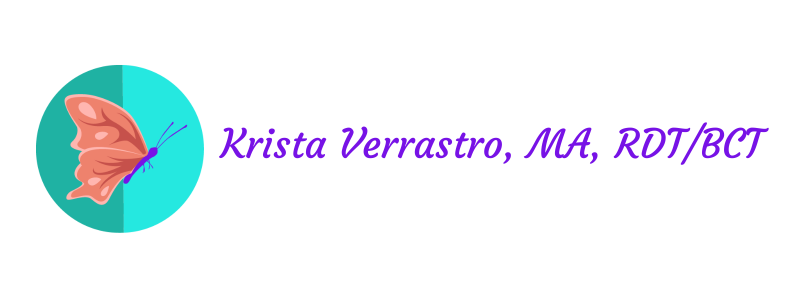
The book I’m reviewing here not only scratches my psychology nerd itch mentioned in my prior book review, it also scratches my itch for the two main modalities I use: EMDR and creative arts therapies (CATs). Even though many of us creative arts therapists have been blending creative approaches with EMDR for years, no such book like this existed until now. It’s very exciting!
The book I’m referring to is EMDR and Creative Arts Therapies. It is edited by Elizabeth Davis, Jocelyn Fitzgerald, Sherri Jacobs, and Jennifer Marchand. It was released in 2022.
I agree with the authors that the CATs complement EMDR very well, especially when helping clients who have complex trauma. I also agree that studies are catching up to what we creative arts therapists have long known about the efficacy of the CATs.
I like this book a lot overall! I took about a year to finish it because after reading many of the chapters I made outlines based on the directives and scripts provided. I immediately implemented much of what I learned with great success!
I think the only [minor] complaint I can think of is that most of the authors are art therapists. I would have liked to see more chapters about using the other CATs (namely drama therapy, psychodrama, dance/movement therapy, music therapy, and poetry therapy). I appreciate that some authors are expressive arts therapists and incorporate all of the modalities. I also recognize that there is a lot of overlap in the modalities in general. If there’s ever a sequel to this book, maybe I can contribute a chapter about using drama therapy in EMDR!
Things I Like About the Book
- It addresses current issues, especially the importance of an integrative and responsive approach when addressing the following: cultural, racial, and diversity issues as well as incorporating arts and somatic-oriented work online.
- It addresses the importance of being mindful regarding certain language around trauma. An example is being mindful that some clients might be uncomfortable with therapists saying “This is a safe space” or asking clients to imagine a safe space. The book suggests that using calm or soothing space might be less triggering.
- The structure is well organized. The first section is about using EMDR and the CATs for various populations. The second section is more focused on concrete tools and perspectives for integrating EMDR and the CATs, including techniques and case studies.
An Overview of the Chapters
Chapter 1
- Defines complex trauma and CPTSD.
- Addresses why these things can feel so difficult to manage for both clients and therapists.
- Addresses common frameworks of working with these issues, such as the EMDR phases and Judith Hermann’s phases of trauma.
- Addresses using a “visual of domains of treatment” with clients to educate them about trauma while also providing a sense of hope, especially when therapy can feel long.
- Includes helpful directives and case examples.
- Reminds us to make things creative. I appreciate the reminder that there are easy ways to get creative with directives that are usually taught as being talking or writing based. For example, it offers a variety of creative ways to do timelines and other history gathering with clients. It also offers ways to provide psychoeducation in creative ways. This is one of many examples of how I thought the book could be helpful even for therapists who are not trained in EMDR.
- Addresses how the CATs offer more opportunities for attunement with clients and how to best attune with them. Some examples it addresses: types of materials offered, when to observe vs when to engage as the therapist, and using containment.
- Addresses CATs techniques and directives to use leading up to reprocessing, during reprocessing, and after reprocessing in EMDR.
Chapter 2
- Addresses cross-cultural applications over telehealth.
- Thoroughly goes through using the acronym COMEBACK to help clients orient to the present (aka grounding or anchoring). Each component of the acronym uses the body and/or the arts. Each component is able to be used in telehealth as well as in-person.
- Emphasizes that moving together as therapist and client can help build connection and help clients focus on interoception. This means that movement can help clients focus on internal cues more when trauma might have caused them to spend much time focusing only on external cues. This is especially important for EMDR since clients are asked to pay attention to body cues throughout the process of it.
- One of my favorite directives in the book came from this chapter: the Scale of Presence. It’s a directive that assesses how present a client feels in any given moment. It can be used online or in-person. This is especially helpful for clients who tend to dissociate.
Chapter 3
- Addresses working with refugees and displaced youth.
- Provides a solid history about why group work is appropriate for teens and how to use EMDR and the CATs in group work.
- Addresses culturally appropriate materials and activities. It provides case studies to illustrate this.
- Reminds us that play is so important for attunement and a sense of mastery (including mastering different roles).
- Focuses on helping clients feel safe in their bodies.
Chapter 4
- Focuses on the gen Z population and their unique issues. Some such issues: the need for therapy to be cost effective and shorter term because of present day financial struggles and busy schedules.
- Provides helpful directives, scripts, and case studies. I think many of these would be useful for all therapists, not just ones trained in EMDR. Three of my new favorite directives came out of this chapter: using art and drama to explore how the amygdala calms down while doing EMDR reprocessing, using the metaphor of a music album to explore memories to be targeted in EMDR reprocessing, and using a triptych drawing to explore the three pronged approach of EMDR.
- Points out that EMDR and the CATs both offer ways to make subconscious experiences conscious in non-traumatizing ways. Talk therapy can feel more re-traumatizing at times because it lacks the containment of the CATs. The CATs also feel more active and empowering.
- Provides some great metaphors for how EMDR reframes narratives. For example, it mentions thinking of distressing memories as red stripes on a candy cane that are erased through EMDR reprocessing. The client then gets to choose a color to imagine for new stripes, and these stripes are the reframed memories and installed positive cognitions.
Chapter 5
- Focuses on art therapy, EMDR, and sensorimotor integration.
- Provides the most trauma therapy theory and framework in the book. It largely does this through a metaphor of a three legged stool, with the legs representing the following: the brain (neuroscience), the body (somatic regulation), and emotions (relational attachment). It addresses how EMDR and the CATs include both “top down” and “bottom up” approaches to therapy.
- Includes case studies.
Chapter 6
- Explores the integration of art therapy, EMDR, and IFS. It includes an overview of IFS.
- Includes directives and case studies for different phases of EMDR and IFS. This includes how to explore parts through bilateral art.
- Includes a helpful chart to help conceptualize working with clients.
Chapter 7
- Focuses on incorporating creative writing into the phases of EMDR. It addresses how writing helps clients get unstuck and gives meaning to suffering.
- Includes helpful directives.
- Emphasizes the importance of clients having healthy coping skills to implement if feeling activated after using writing outside of sessions, such as when journaling. It also emphasizes that writing is more likely to help when people occasionally reflect on their writings.
Chapter 8
- Explores parts work and dissociation. One way it does this is through a helpful metaphor of parts being like various crew members on a submarine.
- Provides directives through the 3-D PoST model, which uses clay figurines to explore parts.
Chapter 9
- Focuses on using the Dancing Mindfulness approach in EMDR. This approach is about seeing life as a dance and viewing all life experiences as opportunities to dance. It is multi-modal so incorporates all the arts.
- I like the point made that the expressive arts therapies are like a buffet, where people can choose from a variety of arts activities. I see drama therapy as similar because drama can include movement, dance, music, writing, and visual arts in addition to the obvious acting.
- I also like the point made that the arts practices that might be least comfortable might have the most to teach us, if we’re willing to explore them.
- I whole heartedly agree that the CATs emphasize process over products. This is a favorite subject of mine to talk about! It means that when arts are used in sessions it’s not important if the creations are “good”, it just matters that the creator explored and expressed themselves.
- Tools to help therapists with self-care are included, and the point is made that therapists can best help their clients if they understand using the arts themselves.
Chapter 10
- Provides a thorough Future Self resourcing intervention. It encourages using arts and somatic methods to help clients have a felt sense of their future self.
- This tool ideally helps clients find what they are passionate about, motivates them towards their future, and helps with readiness for trauma processing.
Chapter 11
- Explores the expressive arts therapies as a multi-modal approach. As it points out: why limit ourselves to “one channel” by only using language in therapy? The CATs and EMDR offer more opportunities for expression and processing.
- Provides practical skills and case studies.
- Includes culturally adaptive approaches while acknowledging that the CATs and bilateral stimulation have indigenous roots and were not created by any particular person.
In Conclusion
I overall enjoyed this book and feel that it contributed a lot to my therapist tool belt. It is one of my new favorite clinical books. I highly recommend it to therapists trained in both EMDR and the CATs. I think that therapists trained in one but not the other can also greatly benefit from it.
Contact Me
If you’re a Maryland resident looking to work with someone who does EMDR and creative arts therapies, feel free to contact me. Even if I’m unavailable work together, I know a few other therapists who do both of these modalities and am happy to provide referrals.
